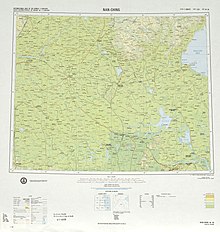Huai-nan
Appearance
English
[edit]
Etymology
[edit]From Mandarin 淮南 (Huáinán), Wade–Giles romanization: Huai²-nan².[1]
Proper noun
[edit]Huai-nan
- Alternative form of Huainan
- 1970, S. A. M. Adshead, The Modernization of the Chinese Salt Administration, 1900-1920[1], Cambridge, Massachusetts: Harvard University Press, →ISBN, →LCCN, →OCLC, page 19:
- Every aspect of the salt trade required official sanction and the issue of permits. As an illustration, let us consider the marketing of a consignment of salt from the Huai-nan salines to an up-river port such as Hankow or Ta-t'ung. The yard merchant (ch'ang-shang) at the salines had to report his output of salt daily to the salt receiver (ch'ang-kuan), and could carry salt for sale to Shih-erh-wei only on the requisition of the Huai-nan general office (Huai-nan tsung-chü) at Yangchow, transmitted through the salt receiver; when he received this, the had to apply back to Yangchow for a transport permit (ch'ung-yen chih-chao) and to his local branch office (fen-ssu) for a cargo certificate (ts'ang-tan).
- 1992, Samuel Adrian Miles Adshead, Salt and Civilization[2], St. Martin's Press, →ISBN, →LCCN, →OCLC, page 84:
- Marco Polo was right to be impressed by Huai-nan and Liang-che. By a mixture of favourable market opportunities, government support and considerably technical ingenuity at least, they recovered a lead for chien over shai in China which was not lost until the nineteenth century.
- 1994 [145–86 BCE], Ssu-ma Chʻien, edited by William Nienhauser, The Grand Scribe's Records[3], volume 1, Indiana University Press, →ISBN, →LCCN, →OCLC, page 206:
- When he reached Yin-ling 陰陵,²⁶⁵ he lost his way and asked an old farmer.[...]
²⁶⁵ A county northwest of modern Ting-yüan 定遠 County in Anhwei (Wang Li-ch'i, 7:182n.) about 25 miles east of modern Huai-nan 淮南 City (see also T'an Ch'i-hsiang, 2:19).
Translations
[edit]Huainan — see Huainan
References
[edit]- ^ Huainan, Wade Giles romanization Huai-nan, in Encyclopædia Britannica
